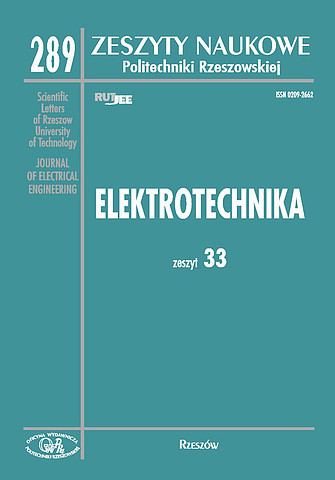Abstract
The aim of this article was to present the investigation results of the energy conversion efficiency in Powercast P2110 Powerharvester. In this subject the aspect of low power energy harvesting has been included. The energy potential of the surrounding environment, the elimination of environmental threats, as well as the increased functionality of electronic modern systems are crucial factors that suggest development effective solutions in the scope of harvesting, processing and energy storing. The energy harvesting technique is useful in many various areas of human social-economic activity. During last years, there was an increase of the electromagnetic fields level observed in the environment. These fields are produced by various types of communications systems. The energy which is transmitted can be harvested and utilized for purpose not associated with the mentioned systems. Currently, there are no effective solutions to energy conversion fields at very low power level and a high variability of these levels. One of the few commercially available solutions to convert rf energy is the Powercast P2110 Powerharvester. The experimental methods of determining energy conversion efficiency in such circuit were presented in this paper. The used methods do not require advanced measurement. The electromagnetic field was generated for research. In the created electromagnetic environment P2110 Powerharvester was placed. A change of distance between the antenna generating an electromagnetic field and P2110 Powerharvester enabled implementation of measurements and estimation the influence of input power level on the energy conversion efficiency at the condition similar to the real application conditions. According to the results, the relative high efficiency is observed for input power level greater than -7 dBm. The load resistance has a significant impact on the efficiency of the process. Generally, load increase causes a reduction in the value of of efficiency value.
References
[2] Yuan F.: CMOS Circuits for Passive Wireless Microsystems, Springer New York Dordrecht Heidelberg London, 2011.
[3] Nasa S.H., Asefi M., Albasha L., Qaddoumi N.: Investigation of RF Signal Energy Harvesting, Hindawi Publishing Corporation, Active and Passive Electronic Components, 2010.
[4] Pinuela M., Mitcheson P.D., Lucyszyn S.: Ambient RF Energy Harvesting in Urban and Semi-Urban Environments, Microwave Theory and Techniques, IEEE Transactions on, 2013. 61(7): p. 2715-2726.
[5] Jankowski-Mihułowicz P.: Field Conditions of Interrogation Zone in Anticollision Radio Frequency Identification Systems with Inductive Coupling, Radio Frequency Identification Fundamentals and Applications, Bringing Research to Practice, Turcu, C., INTECH, 2010.
[6] Penella-López M.T., Gasulla-Forner M.: Powering Autonomous Sensors, Springer Dordrecht Heidelberg London New York, 2011.
[7] Jankowski-Mihułowicz P., Węglarski M.: Wyznaczanie obszaru poprawnej pracy systemów RFID działających w paśmie UHF, Pomiary Automatyka Kontrola, 2011. 57: p. 1469-1472.
[8] Sudou M., Takao H., Sawada K., Ishida M.: A novel RF induced power supply system for monolithically integrated ubiquitous micro sensor nodes, Sensors and Actuators A: Physical, 2008. 145–146(0): p. 343-348.
[9] Marian V., Vollaire C., Allard B., Verdier J.: Low power rectenna topologies for medium range wireless energy transfer, Power Electronics and Applications (EPE 2011), Proceedings of the 2011-14th European Conference on. 2011.





